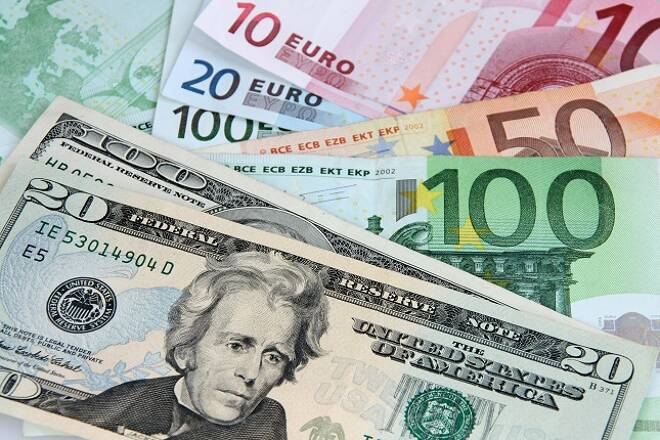Advertisement
Advertisement
EUR/USD Daily Technical Analysis for June 21, 2017
By:
The EUR/USD is trading lower, weighed down by a weaker than expected German PPI report, and the narrowing of the EMU current account. The EU and the UK
The EUR/USD is trading lower, weighed down by a weaker than expected German PPI report, and the narrowing of the EMU current account. The EU and the UK agreed on a timetable for Brexit, while the Fed’s Rosengren discussed the need for higher rates.
Technicals
The EUR/USD moved lower, and is forming a toping pattern which appears to look like a head and shoulder reversal pattern. Prices broke through trend line support which is now seen as resistance near an upward sloping trend line near 1.1165. Additional resistance is seen near the 10-day moving average at 1.1187. Support is seen near the May 29 lows at 1.1109. Momentum is negative and accelerating lower as the MRSI (relative strength index) broke down. The current reading of 48, is in the middle of the neutral range.
German PPI was Weaker than Expected in April
Germany revealed a weaker than expected German PPI and separately there was a release of the Eurozone current account and balance of payments numbers for April, which both had little impact. Meanwhile the official press conference after Monday’s first round of Brexit talks was amicable, but brought little more than a time table for discussion topics going ahead, although it is clear now that there won’t be parallel talks on a post-Brexit trade deal, something the U.K. had been keen on.
The EMU Current Account Narrowed in April
EMU current account surplus narrowed in April. The Eurozone current account surplus narrowed to a seasonally adjusted EUR 22.2 billion, from EUR 35.7 billion in the previous month. The unadjusted Financial Account showed direct and portfolio investment inflows of EUR 69.9 billion in April, with accumulated inflows of EUR 579.8 billion in the 12 months to April this year, compared to EUR 591.7 billion in the 12 months to April 2016. Direct investment flows equity investment are improving, leaving direct investment inflows at EUR 170.9 billion in the 12 months to April this year, up from just EUR 78.7 billion in the 12 months to April 2016. Portfolio investment inflows meanwhile seem to have peaked and are trending lower.
The UK Car Industry is at Risk from Brexit
The UK car industry at risk of permanent damage from Brexit warns the Society of Motor Manufacturers and Traders, arguing that an interim trade agreement between March 2019, when the UK will exit the EU, and the time when a full trade deal can be reached. The chief executive of SMMT highlighted that striking a post-Brexit trading deal would require the agreement of 27 nations, a process that would likely need five years, much more than 21 months available under Article 50. He also stressed that uncertainty risks death by a thousand cuts. Yesterday’s commencement of the negotiating process, which so far has focused on basic issues of procedure, has brought Brexit risks back into sharp focus. The pound is trading under pressure as there appears to be de facto shift to a softer Brexit stance, with the minority government now forced to take a consensus-building approach.
EU and UK Agree on Brexit Time Table
EU and U.K. agree timetable for Brexit talks, with initial negotiating groups tackling first Citizens’ rights, financial settlement and finally other separation issues. An additional dialogue on Ireland/Northern Ireland has been launched, but there was no mention of a post-Brexit trade deal which the U.K. initially wanted to negotiate alongside the divorce terms.
BoE’s Carney says that njow is not the time to raise interest rates, adding the domestic inflation pressures are subdued, and there are “mixed signals” on consumer spending and investment. Carney said any rate increases will be limited and gradual as we must see how the economy reacts to the reality of Brexit. He added that current-account sustainability depends on Brexit.
The Fed’s Rosengren Said Low Rates Risk Stability
The Fed’s Rosengren said low rates pose financial stability issues, in his comments at the Riksbank macroprudential conference. The Boston Fed president turned decidedly hawkish about a year ago and has maintained that outlook ever since. He believes low rates put intermediaries and economies at risk, make fighting future recessions more difficult, and make it more likely central banks will have to resort to non-traditional policies.
U.S. Current Account Widened
U.S. current account deficit widened -$2.8 billion to -$116.8 billion in Q1 after the $3.7 billion widening to -$114.0 billion in Q4 which was revised from -$112.4 billion. The Q3 deficit was bumped up to -$110.3 from -$116.0 billion. The goods and services deficit popped out to -$139.0 billion from the prior -$134.0 billion which was revised from -$132.3 billion. The primary income surplus fell to $47.7 billion from $51.3 billion which was revised from $61.5 billion.
U.S Chain Store Sales Increased in Latest Week
U.S. chain store sales rose 2.5% in the week ended June 17, after a 1.1% rebound in the June 10 period. It’s the first back-to-back gain since the April 22 week. Compared to last year, sales edged up to a 0.5% year over year pace from 0.4% year over year. Father’s Day shopping was supportive, as was the heat wave.
About the Author
David Beckerauthor
David Becker focuses his attention on various consulting and portfolio management activities at Fortuity LLC, where he currently provides oversight for a multimillion-dollar portfolio consisting of commodities, debt, equities, real estate, and more.
Did you find this article useful?
Latest news and analysis
Advertisement
